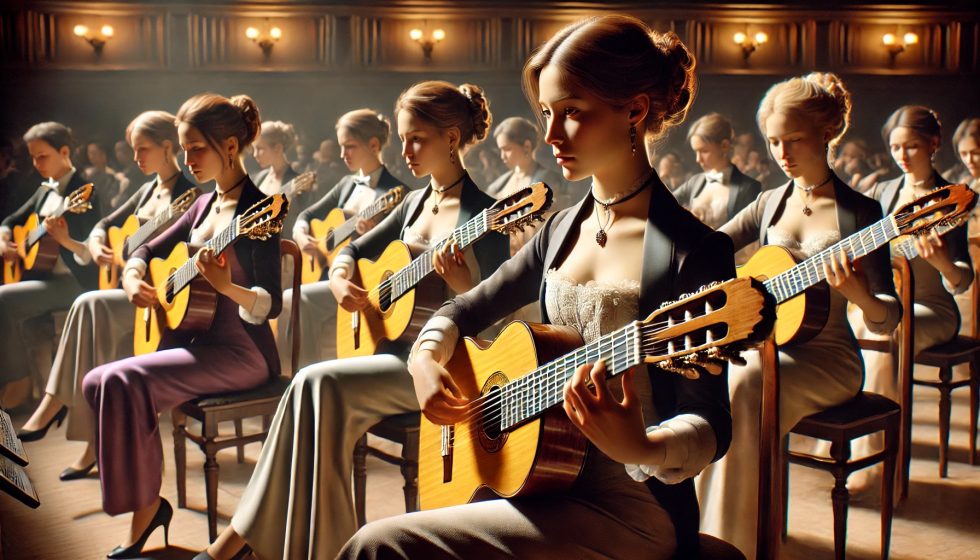
The Rise of Female Classical Guitarists: A New Era of Music
Introduction
The classical guitar world is experiencing a transformation, with female guitarists playing a pivotal role in reshaping its future. These musicians bring fresh perspectives, innovative techniques, and a more inclusive approach to the art form, diversifying the classical guitar landscape. In this article, we explore the contributions of some of the most prominent female classical guitarists, highlighting their unique styles and the lasting impact they are making on the field.
Pioneers and Trailblazers
Though women have long been involved in classical guitar, their influence has surged in recent years, with many becoming key figures in the global scene. Here are a few trailblazers who have shaped the path for future generations:
- Liona Boyd: Dubbed “The First Lady of Guitar,” Boyd’s distinct blend of classical and folk music, alongside her extensive recording career, has made her an internationally celebrated figure in classical guitar.
- Sharon Isbin: A multiple Grammy Award winner, Isbin is renowned for her exceptional technique and groundbreaking achievements as a performer and educator. She has paved the way for many female guitarists by breaking barriers in an otherwise male-dominated field.
- Ana Vidović: Hailing from Croatia, Vidović is known for her flawless technical mastery and emotive performances. She has captivated audiences worldwide and continues to inspire a new generation of classical guitarists.
A New Wave of Talent
In recent years, a new generation of female classical guitarists has emerged, achieving widespread acclaim and pushing the boundaries of what the instrument can do. These musicians are infusing the classical guitar world with fresh ideas and diverse influences, making waves in the industry:
- Meng Su: As part of the Beijing Guitar Duo, Meng Su has become known for her virtuosic performances that blend classical and contemporary styles. Her versatility and musicality have made her one of the standout classical guitarists of her generation.
- Berta Rojas: A celebrated Paraguayan guitarist, Berta Rojas is known for her dedication to promoting Latin American composers and her ability to seamlessly blend classical guitar with folk traditions. Her artistry and advocacy for underrepresented composers have garnered her international recognition.
- Xuefei Yang: One of the first Chinese guitarists to achieve international fame, Yang has carved out a distinguished career by fusing Eastern and Western musical traditions. Her innovation and technical prowess have led to collaborations with some of the world’s top orchestras and composers.
Expanding the Repertoire
Female classical guitarists are not only making their mark as performers but also in expanding the guitar’s repertoire. They have worked with composers to commission new pieces and have adapted works from other instruments to enrich the guitar’s expressive potential.
- Clarice Assad: A prolific composer and performer, Clarice Assad has contributed numerous works to the classical guitar repertoire, often incorporating Brazilian rhythms and contemporary sounds into her compositions.
- Dale Kavanagh: A guitarist and composer, Kavanagh has enriched the classical guitar repertoire by adapting and arranging pieces from other genres and eras. Her contributions have expanded the instrument’s musical language, bringing new and exciting works to the concert stage.
Education and Mentorship
One of the most impactful roles that female classical guitarists play is in education. Many of these artists are also dedicated educators who have taken up positions at prestigious universities and conservatories around the world. Their mentorship and guidance are crucial in nurturing the next generation of classical guitarists:
- Sharon Isbin has been a leading figure at the Juilliard School, where she has mentored numerous young guitarists. Her influence as an educator is as profound as her performing career, inspiring students to reach new heights.
- Berta Rojas, in addition to her performing career, has been heavily involved in education, promoting guitar studies in her native Paraguay and worldwide. She has also used digital platforms to reach a broader audience of students and enthusiasts.
Challenges and Triumphs
Despite the notable rise of female classical guitarists, challenges still exist. Issues of gender bias, unequal representation in competitions, and disparities in professional opportunities remain obstacles for many women in the field. However, many female guitarists are working to dismantle these barriers through advocacy, collaboration, and by raising awareness of these inequities.
Organizations dedicated to gender equality in music, as well as initiatives by individual artists, have been instrumental in driving change. Through concerted efforts, these challenges are gradually being addressed, and the classical guitar world is becoming more inclusive.
Festivals and Collaborations
Festivals and events dedicated to showcasing female classical guitarists have been on the rise, creating spaces where their artistry can be celebrated and highlighted. These platforms not only promote visibility but also foster collaboration between artists across genres and disciplines. Such initiatives help create a vibrant and interconnected musical ecosystem, where new ideas and innovations thrive.
- The Women in Classical Guitar Festival: This event highlights the contributions of female guitarists and composers, offering a platform for them to perform and engage in discussions on gender and representation in classical music.
- Collaborative Projects: Female guitarists are increasingly engaging in collaborations with musicians from various genres, including orchestral, jazz, and contemporary music, enriching the classical guitar tradition with new influences.
Conclusion
The rise of female classical guitarists represents an exciting and promising development in the world of classical music. Their creativity, talent, and resilience have brought new energy and perspectives to the classical guitar community, laying the groundwork for a more inclusive and diverse future. By celebrating and supporting the achievements of female guitarists, we not only enrich the musical landscape but also embrace a new era that recognizes and values the unique voices of all artists.
This shift signals the start of a more open and vibrant chapter in classical guitar history, where diversity in artistry is both celebrated and embraced.

















